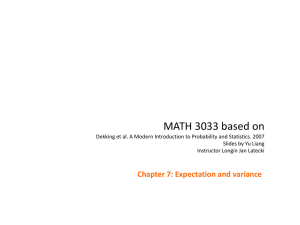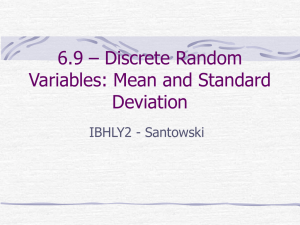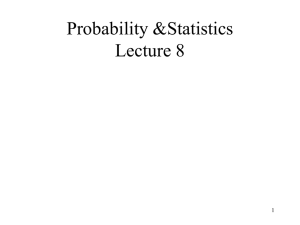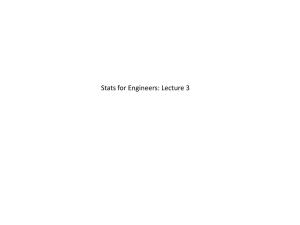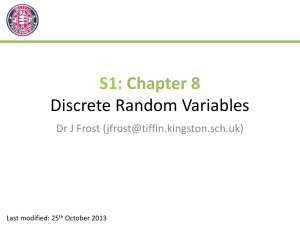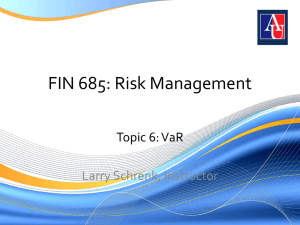Expectation and variance
advertisement
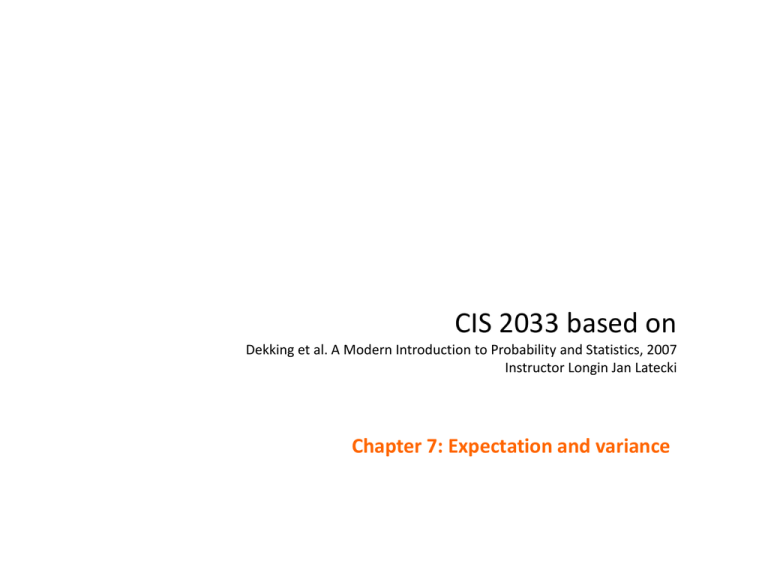
CIS 2033 based on Dekking et al. A Modern Introduction to Probability and Statistics, 2007 Instructor Longin Jan Latecki Chapter 7: Expectation and variance The expectation of a discrete random variable X taking the values a1, a2, . . . and with probability mass function p is the number: E[ X ] ai P(X ai ) ai p(ai ) i i We also call E[X] the expected value or mean of X. Since the expectation is determined by the probability distribution of X only, we also speak of the expectation or mean of the distribution. Expected values of discrete random variable Example • Let X be the discrete random variable that takes the values 1, 2, 4, 8, and 16, each with probability 1/5. Compute the expectation of X. E[ X ] ai P(X ai ) ai p(ai ) i i Bernoulli Distribution • Let X have Bernoulli distribution with the probability of success p. E[ X ] ai P(X ai ) ai p(ai ) i i E ( X ) xP( x ) (0)(1 p ) (1)( p ) p x Var( X ) ( x p ) 2 P ( x ) (0 p ) 2 (1 p ) (1 p ) 2 ( p ) x p(1 p )( p 1 p ) p(1 p ) Var ( X ) E[( X E[ X ])2 ] Binomial Distribution • Let X have Binomial distribution with the probability of success p and the number of trails n. • Computing the expectation of X directly leads to a complicated formula, but we can use the fact that X can be represented as the sum of n independent Bernoulli variables: X X 1 ... X n E ( X ) E ( X 1 ... X n) E ( X 1 ) ... E ( X n) p ... p np Var( X ) Var( X 1 ... X n) Var( X 1 ) ... Var( X n) np(1 p ) Note: We do not need the independence assumption for the expected value, since it is a linear function of RVs, but we need it for variance. Geometric Distribution • Let X have Geometric distribution with the probability of success p. E[ X ] ai P(X ai ) ai p(ai ) i 1 1 E ( X ) x(1 p ) p p 2 (1 (1 p )) p x 1 1 p Var( X ) 2 p x We skip the derivation of variance. i The expectation of a continuous random variable X with probability density function f is the number E[ X ] xf ( x)dx We also call E[X] the expected value or mean of X. Note that E[X] is indeed the center of gravity of the mass distribution described by the function f: E[ X ] xf ( x)dx xf ( x)dx - f ( x)dx - Expected values of continuous random variable Uniform U(a,b) • Let X be uniform U(a, b). Then f(x)= 1/(b-a) for x in [a, b] and zero outside this interval. E[ X ] xf ( x)dx 1 1 b2 a 2 b a 1 2 1 E ( X ) xf ( x )dx x dx x ba 2 2 b a a 2 b a a b (b a ) 2 Var( X ) E ( X ) E ( X ) 12 2 2 b The EXPECTATION of a GEOMETRIC DISTRIBUTION. Let X have a geometric distribution with parameter p; then E[ X ] kp(1 p)k 1 k 1 1 p The EXPECTATION of an EXPONENTIAL DISTRIBUTION. Let X have an exponential distribution with parameter λ; then E[ X ] xe dx x 0 1 The EXPECTATION of a NORMAL DISTRIBUTION. Let X be an N(μ, σ2) distributed random variable; then 1 X ( 1 E[ X ] x e 2 2 )2 dx The CHANGE-OF-VARIABLE FORMULA. Let X be a random variable, and let g : R → R be a function. If X is discrete, taking the values a1, a2, . . . , then E[ g ( X )] g (ai )P(X ai ) i If X is continuous, with probability density function f, then E[ g ( X )] g ( x ) f ( x ) dx Example: Let X have a Ber(p) distribution. Compute E(2X). The variance Var(X) of a random variable X is the number Var ( X ) E[( X E[ X ])2 ] Standard deviation: std Var ( X ) Variance of a normal distribution. Let X be an N(μ, σ2) distributed random variable. Then 1 x ( 1 2 Var ( X ) ( x ) e 2 2 )2 dx 2 Variance of an EXPONENTIAL DISTRIBUTION. Let X have an exponential distribution with parameter λ; then Var ( X ) 1 2 An alternative expression for the variance. For any random variable X, Var ( X ) E[ X 2 ] E[ X ]2 E[ X 2 ] is called the second moment of X. We can derive this equation from: Var ( X ) E[( X E[ X ]) ] ( x E[ X ] ) f ( x )dx ( x 2 2 xE[ X ] ( E[ X ])2 ) f ( x )dx 2 2 x f ( x)dx 2E[ X ] xf ( x)dx ( E[ X ]) 2 ( E[ X 2 ]) ( E[ X ])2 2 f ( x )dx E[ X 2 ] 2( E[ X ])2 ( E[ X ])2 Example. Let X takes the values 2, 3, and 4 with probabilities 0.1, 0.7, and 0.2. We can compute that E[X]= 3.1. Var ( X ) E[( X E[ X ])2 ] Var ( X ) E[ X 2 ] E[ X ]2 Expectation and variance under change of units. For any random variable X and any real numbers r and s, E[rX s] rE[ X ] s and Var (rX s) r 2Var ( X )

